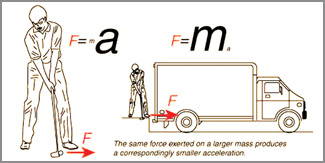|
The World
of Science
Newton's Laws of Motion
Those
of you in the upper grades are sure to have learnt about Newton's Laws
of Motion in your science class. For those of you who don't know what
these laws are, this article will be good reading.
|

Sir Isaac Newton |
Those of you who have learnt it can also keep reading to see whether
you can grab some additional information for your knowledge. Newton's
Laws of Motion are three physical laws which provide relationships
between the forces acting on a body and the motion of the body; Sir
Isaac Newton compiled these laws.
Newton's Laws were first published together in his work Philosophiae
Naturalis Principia Mathematica (1687).
These laws form the basis for classical mechanics, which made a great
difference and influenced the development in physics. Newton used these
laws to explain many results concerning the motion of physical objects.
In the third volume of the text, he showed that the Laws of Motion,
combined with his Law of Universal Gravitation, explained Kepler's laws
of planetary motion. Newton's Laws of Motion describe the acceleration
of massive objects.
First Law
If no net force acts on a particle, then it is possible to select a
set of reference frames, called inertial reference frames, observed from which the particle moves without any change in
velocity (speed).
frames, observed from which the particle moves without any change in
velocity (speed).
Have you ever ridden in a car and experienced the driver suddenly
crashing on the brakes? How did your body move as the car came to a
stop? You probably felt your body moving forward.
When you felt this happening, you experienced Newton's First Law of
Motion. In the car, your body was in motion, travelling at the same
speed as the car.
When the car stopped, your body stayed in motion. If you were not
wearing a seatbelt and you were travelling very fast, your body could
continue to move forward through the windshield!
Second Law
Observed from an inertial reference frame, the net force in a
particle is proportional to the time rate of change of its linear (in a line) momentum. Momentum is the product of mass and
velocity.
of its linear (in a line) momentum. Momentum is the product of mass and
velocity.
This law is often stated as F = ma (where F = force, m = mass and a =
acceleration (the force on an object is equal to its mass multiplied by
its acceleration).
Third Law
Whenever a particle (A) exerts a force on another particle (B), B
simultaneously (at the same time) exerts a force on A with the same magnitude (strength) in the opposite direction.
force on A with the same magnitude (strength) in the opposite direction.
The strong form of the law further postulates (assumes) that these
two forces act along the same line. The experiment given here is a good
example to show Newton's Third Law of Motion. In the given
interpretation, mass, acceleration and most importantly, force are
assumed to be externally defined quantities.
This is the most common, but not the only interpretation: one can
consider the laws to be a definition of these quantities.
***
Note that
the Second Law only holds when the observation is made from an inertial
(non-moving) reference frame, and since the First Law defines an
inertial reference frame, asking proof of the First Law from the Second
Law is a logical myth.
***
Experiment
What you will need
* A biscuit box
* A balloon
* Straws
* Four thread spools
* Some straight pins
Method
* The box can be the body of the car. Clean the box and cut off the
top.
* Then cut it in half across the long side.
* Cut a small hole in the middle of one of the short sides of the
box. This is where the balloon goes in. You will probably have to adjust
the size of the hole. If it is too big or too small, there will not be
enough force to move the car.
* Put the balloon through this hole, but do not blow it up yet.
* The next thing you do is make holes on each side of the box for the
axles and stick straws through these holes. Make sure they are close to
the bottom.
* Then attach the spools to the straws and put pins through the
straws to keep the spools on.
* Now, blow up the balloon - do not tie the end - and let your car
go!
Compiled by Janani Amarasekara |
